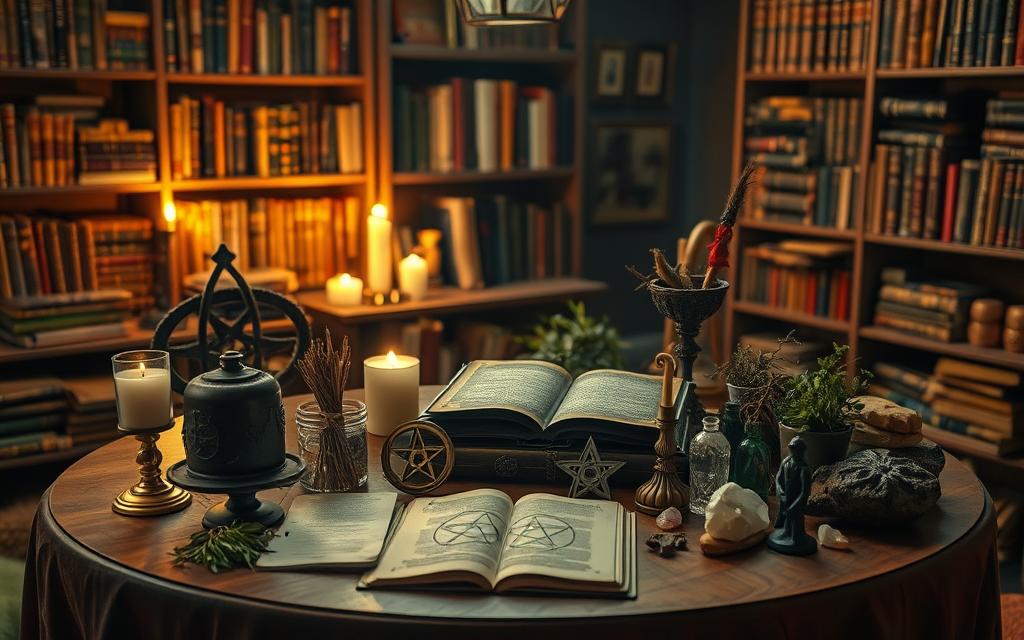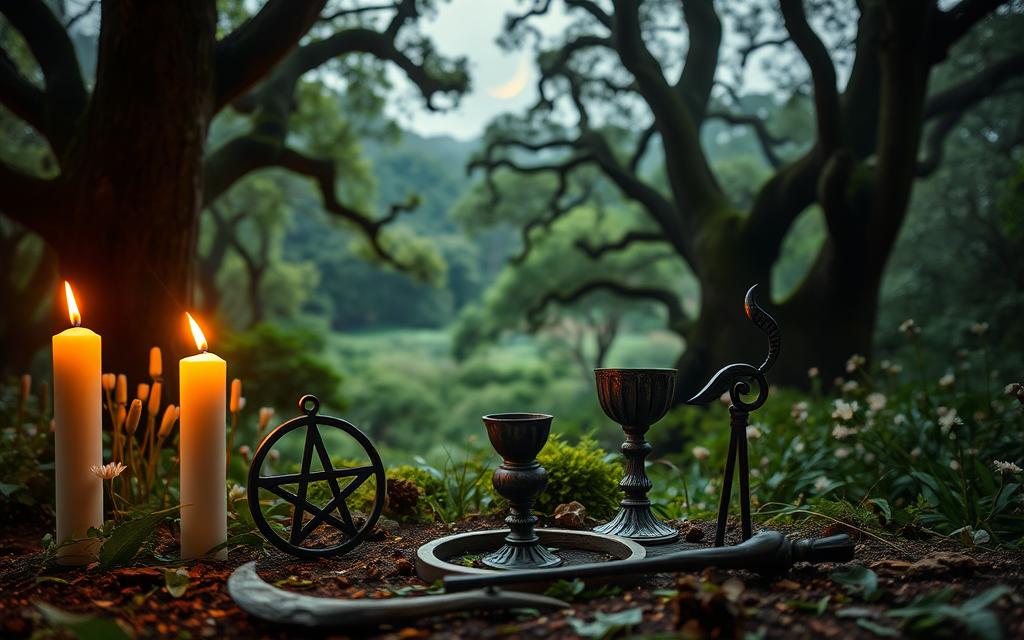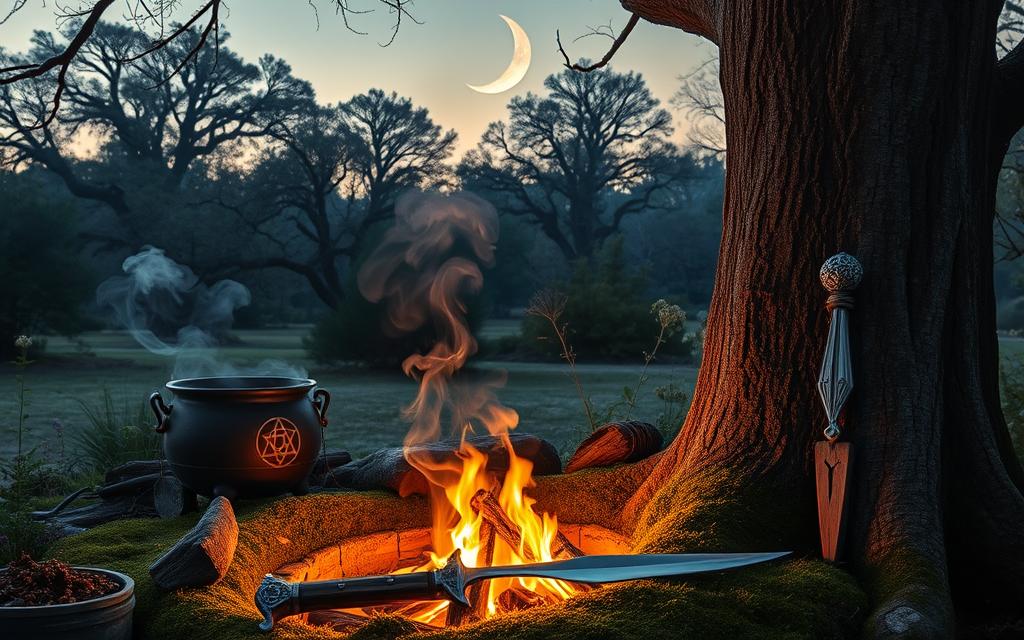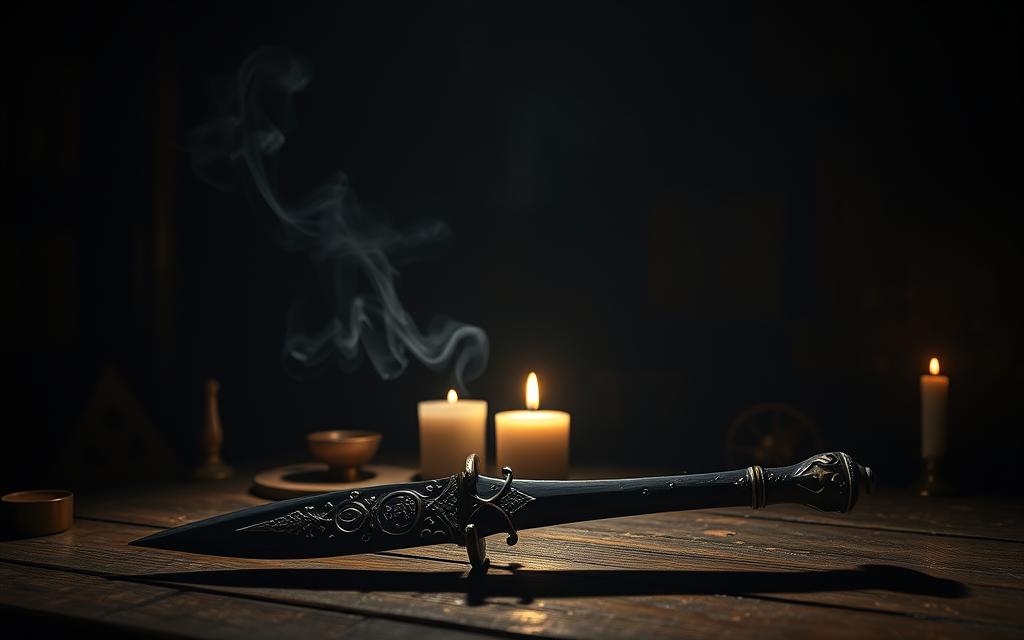Ever wondered why certain magical tools are key in Wicca? They can change your spiritual rituals. Each tool, from the altar to the wand, has its own purpose and power. By learning how to use them, you can create special spaces, focus energy, and follow deep traditions.
In this comprehensive guide, we dive into the history and meaning of these tools. This guide is for both new and experienced Wiccans. It shows how important these tools are in spiritual ceremonies.
We cover everything from the eight Sabbats to the details of tool consecration. Learn how tools like candles, chalice, wand, and athame help you connect with the divine. They make your intentions clearer.
Let’s explore how to use and care for these magical tools. This will make your spiritual practice more meaningful and powerful.
Introduction to Wicca Tools
Wicca is a modern Pagan religion that draws from ancient traditions. Tools are key for rituals and connecting with the divine. Knowing about Wicca tools and their history can improve your practice.

Defining Wicca Tools
Wicca tools are sacred objects used in rituals. They include the athame, chalice, pentacle, and wand. These items symbolize the elements and are used in casting circles and spells.
Tools are purified and consecrated to boost their power. This is done through smudging with sage or a Moon bath.
The Role of Gerald Gardner
Gerald Gardner is known as the father of modern Wicca. He popularized it in the mid-20th century. Gerald Gardner Wicca includes rituals, beliefs, and tools used today.
Gardner stressed the need for sacred tools to connect with spiritual energies. His teachings have inspired many to use these tools in their practices.
Why Wicca Tools are Important
Wicca tools are vital for a meaningful practice. They are not just objects but carry the practitioner’s intent and energy. They help create a sacred space and channel spiritual energy.
Tools can be bought or made with love. Cleansing and consecrating them is essential. This makes them effective for spiritual work.
In summary, Wicca tools are essential for Wiccan practice. They connect the physical and spiritual realms. Proper use and care make rituals more powerful and meaningful.
Symbolism and Significance of Wicca Tools
Wicca tools carry deep meaning and spiritual importance in rituals. Each tool symbolizes different elements and spiritual realms. In Gardnerian Wicca, making or engraving one’s own tools is a big step. It helps deepen the connection to the practice.
Tools like the pentacle, Athame, wand, and chalice are key in Wicca rituals. They represent the natural elements. Understanding these symbols helps practitioners connect deeply with their faith.

The Athame, with its black handle, is seen as the Witch’s weapon. It stands for fire. The wand, often linked to air, can also symbolize fire, showing the power of intentions.
The chalice, a symbol of the Goddess, represents her womb. It’s used to hold wine in rituals, showing the importance of nourishment and creation. The cingulum, a nine-foot cord, symbolizes the magical number three times three. Its color shows the wearer’s rank, like in Australian covens.
Tools like the scourge and besom are also important in Wicca rituals. The scourge stands for sacrifice and suffering in initiation rites. The besom, used in handfasting and fertility dances, represents fertility. About 90% of Wiccans use ritual tools, with 70% using the chalice, wand, pentacle, Athame, censer, and candles in their Wicca rituals.
These tools, made from natural materials, are more than objects. They are channels for spiritual energy. Many believe in making their own tools, feeling a stronger bond with them. This practice helps deepen the connection between the practitioner and their tools, making rituals more powerful.
The History of Wicca Tools
Wiccan tools have roots in pre-Christian rituals and ancient European traditions. These tools have evolved over time, shaping modern Wicca. Their history shows a blend of old customs and new practices.

Pre-Christian Roots
Long before Christianity, ancient cultures used spiritual tools in their rituals. The Celts, for example, used cauldrons and knives in their ceremonies. These tools helped connect people with the divine, strengthening their beliefs.
Ancient European Influences
Today’s Wicca draws from ancient European traditions. The Greeks, Romans, and Norse used tools like wands and chalices in their rituals. These tools were key in ceremonies, helping to channel divine energy.
Gerald Gardner played a big role in preserving these traditions. He made them relevant for today’s Wiccan rituals. This shows how Wicca has evolved, keeping its roots alive.
Wiccans have made these tools their own, adapting them to their needs. This shows Wicca’s ability to stay connected to its past while evolving. It’s a testament to Wicca’s flexibility and enduring spirit.
Consecrating Wicca Tools
Exploring Wicca often means preparing for rituals and consecrating tools. Many modern Pagans purify their tools to remove negative energies. Even though some think their energy can be enough, many believe in the power of consecration.
Why Consecration Matters
Consecrating tools is key to dedicating them for magic. It purifies them, making magic more focused and powerful. Interestingly, all agree that consecrated tools should only be used for magic.
Some also use these tools to consecrate new ones. This builds a chain of energy transfer among the tools.
Steps to Consecrate Your Tools
To consecrate tools, you need to offer to the four elements: salt for Earth, incense for Air, a candle for Fire, and water for Water. Here’s how to do it:
1. Gather Your Materials
You’ll need a white candle, water, salt, and incense. These are common across many traditions.
2. Create Your Sacred Space
Start by setting up a sacred area. This can be inside or outside, with many preferring Nature.
3. Cleanse the Tool
Clean the tool before consecration. Methods include palo santo smoke or more complex rituals. Most prefer cleansing over consecration.
4. Perform the Consecration
Light the candle and place it on your altar. Hold the tool over each element, focusing on your intention. Say a prayer or affirmation for each, dedicating the tool to its magical purpose.
5. Use the Tool Immediately
Use the tool right after the ritual to bind the consecration. This strengthens its energy and connections.
While methods may differ, many traditions stress that there’s no one right way. Over 80% of discussions focus on personal experiences and preferences. This shows how diverse and subjective these practices are.
Wicca Tools for Beginners
Starting your Wicca journey is both thrilling and a bit daunting. As a beginner, picking the right tools is key. This beginner’s guide to Wicca will guide you in choosing your first tools. It focuses on what’s truly important.
Essential Tools List
You don’t need a lot of tools to begin with Wicca. Here’s a list of basic Wicca tools every beginner should have:
- Athame: A double-edged knife for directing energy, often with symbols.
- Wand: A wooden wand for channeling intentions in rituals.
- Chalice: A silver cup for holding offerings in rituals.
- Book of Shadows: A journal for documenting spells and rituals.
- Pentacle: An altar tile representing the five elements, made from wax or other materials.
- Altar Cloth: Sets the mood for your altar, like a green cloth for prosperity.
- Incense Burner: Needed for burning incense to purify the space.
Choosing Your First Tools
When selecting magical tools, pick items that feel right to you. They should match your intentions and energies:
- Personal Connection: Choose tools that resonate with you.
- Accessibility: Make sure your tools are easy to store and carry.
- Quality Over Quantity: It’s better to have a few well-made tools than many.
- Simplicity: Start with the basics and add more as you grow.
Pentacle: The Center of Wiccan Practice
The pentacle is key in Wiccan rituals, showing deep symbolism tied to elements and spirit. It has a long history, used in ancient Sumerian and Greek times. Gerald Gardner, known as Wicca’s founder, brought it into modern rituals in the 20th century.
Symbolism of the Pentacle
The pentacle is a five-pointed star in a circle. It shows the balance of earth, air, fire, water, and spirit. The circle around it means the cycle of life and unity.
The pentacle’s direction matters. An upright one protects against bad energy. But, an inverted pentacle is seen as more negative in some traditions.
Using the Pentacle
Using pentaclesin rituals has many uses. They help channel energy and mark sacred areas. In magic, they help call or banish elemental powers.
The pentacle is also used to bless tools and during the cakes and ale ceremony. It shows the connection to divine forces. Its role in Wicca is vital, showing the importance of managing energy well. For more on clearing and charging tools, click here.
The Athame: Wicca’s Ritual Knife
The athame is a key tool in Wiccan rituals, filled with deep spiritual meaning. It’s a double-edged knife used to guide energy, draw circles, and call upon elemental guardians. It’s not for cutting, but for spiritual work.
Symbolism of the Athame
The athame symbolism is rich and complex. Its dual edges show its role in directing spiritual energy, not cutting. It’s linked to Fire or Air, representing masculine strength or intellectual clarity.
The Hermetic Order of the Golden Dawn helped shape Wiccan practices, linking the athame to Air. The handle is often black, taking in negative energies. Carvings on the handle add personal touches and energies.

Using the Athame
Directing energy in sacred spaces is a main use of the athame. The High Priest or Priestess uses it to draw a protective circle. It also calls upon elemental guardians through pentagrams.
Traditionally, the athame is not for cutting. But some modern practices allow it for inscribing symbols or harvesting herbs. A separate knife, the boline, is used for cutting tasks.
The athame represents fiery masculine energy, complementing the chalice’s intuitive feminine energy. Together, they bring balance and unity to rituals. The energy from rituals is stored in the athame’s handle, ready for future use.
Touching another person’s athame without permission is seen as a grave offense. This shows how personal and sacred this tool is.
For more on mindful practices in Wicca, check out this resource on self-hypnosis techniques.
The Chalice: Emblem of the Goddess
The chalice is very important in Wiccan practice. It represents the feminine divine. In rituals, it holds wine or water, symbolizing life and spiritual abundance.

Symbolism of the Chalice
In Wicca, the chalice shows the goddess’s power. It’s not just a container; it’s the womb of the Great Goddess. It stands for creation and nurturing.
Chalices are made from materials like silver, gold, and copper. Each material has its own meaning. For example, silver is for the moon and femininity, while gold is for the sun and masculinity.
Some Wiccan traditions, like the Alexandrian, use different tools instead of the chalice. This shows how important it can be in different ways.
Using the Chalice in Rituals
Using chalices in rituals is full of tradition and meaning. People often drink from it, showing unity in the circle. The liquid in the chalice, like wine or water, changes the ritual’s purpose.
The size of the chalice also matters. A big chalice means abundance, while a small one means personal power.
Before using the chalice, it must be cleansed and consecrated. This means washing it, casting a circle, and using sage smoke or candle flame. After, it can be decorated with personal symbols to boost its magical power.
On the altar, the chalice is with other important tools like the athame and pentacle. It shows the cycle of life and the divine feminine.
The Wand: Channeling Your Intentions
Magic wands are key in Wicca, helping practitioners focus their magic. These tools carry deep spiritual meaning and a long history. They go back to ancient times and are used today in Wicca.
Symbolism of the Wand
The wand is linked to air in Wicca, standing for communication and thought. It also ties to fire, showing change and will. The ancient Greeks used wands, like Hermes’, for trade and talks.
In Wicca, wands help direct spiritual energy. They connect the physical and spiritual worlds. Wands are made from different woods, each with its own magic. Oak is for strength, and willow for healing.

Using the Wand
Wiccan rituals use wands to draw symbols and call on gods. It’s key to know how to use the wand to direct spiritual energy. Wands help focus spells and connect with spirits.
To make a wand ready for magic, you need to bless it with earth, air, fire, and water. This makes it strong for magic. Clean it often with moonlight or sage to keep its power.
Wands are also in movies like “Harry Potter”, making them popular again. But their true purpose in Wicca is to channel intentions and connect with the spiritual world.
Other Essential Wicca Tools
Wiccans use more than just athames and chalices. They also have censers, cauldrons, and brooms. Each tool has its own role and meaning, making them key in Wiccan rituals.
Censer and Incense
The censer is a vessel for burning incense. It’s used to purify spaces and welcome good energies. Burning incense is a tradition that goes back centuries.
It’s believed to clear out bad vibes and help connect with the spiritual world. This makes it a must-have in many ceremonies.
The Cauldron
Magical cauldrons hold deep meaning in Wicca. They symbolize change and new beginnings. Cauldrons are used in spells and rituals, representing the cycle of life and death.
They sit at the center of the altar, symbolizing the Goddess’s womb and the power of creation.
Broom (Besom)
Wicca brooms, or besoms, are key for cleaning spaces. They’re not like regular brooms. They’re used to sweep away bad energies, making spaces ready for rituals.
This tradition comes from old times. Sweeping was a way to clear the old and welcome the new. It keeps magical spaces pure and safe.
Wicca Tools in Rituals
In Wiccan rituals, tools like athame, chalice, and wand are key. They help set up a *sacred space* and focus the intention of those involved. These tools make it easier to perform *ritual practices*.
Creating Sacred Space
Creating a *sacred space* is vital in Wiccan rituals. The athame is used to draw a circle, marking a protected area. This area is free from distractions, allowing for deep focus.
The pentacle, representing Earth, is placed at the altar’s center. It grounds the energy and serves as a spiritual focal point. Incense from a censer purifies the space, preparing it for rituals.
Enhancing Focus and Intention
After setting up the *sacred space*, tools help focus intentions. The wand, linked to Air or Fire, directs energy and invokes elements. It channels intentions towards desired outcomes.
The chalice, though not in all traditions’ core tools, is vital. It symbolizes the Goddess’s power and is shared to unite energies. This sharing enhances the ritual’s power by focusing intentions collectively.
Tools like cords and the scourge also play roles in rituals. The nine-foot cord represents the number three, a key number in Wicca. The scourge, with eight tails, shows the importance of numbers and symbols in *ritual practices*. These tools help maintain focus on intentions.
Using these tools in rituals, Wiccans create a *sacred space* and improve their ability to *focus intention*. Each tool, from athame to chalice, has a unique role. Together, they make rituals more effective.
Personalizing Your Wicca Tools
Personalizing ritual tools is a unique journey that deepens your spiritual connection. By choosing tools that reflect your personal connection and elemental symbolism, you make your rituals more meaningful. This process adds a special touch to your spiritual practices.
Choosing Based on Personal Connection
It’s important to pick Wicca tools that feel special to you. The weight, texture, and look of a tool can create a strong bond. For example, a tool with natural flaws can become uniquely yours.
Many practitioners, about 60%, make their tools personal to add significance. This might be a wand from a favorite tree or a chalice passed down. These personal touches energize and empower your rituals.
Elemental Representation
Choosing tools based on elemental symbolism also enriches your rituals. Each element—Earth, Air, Fire, Water, and Spirit—has its own tool. For example, the pentacle at the altar’s center represents all elements and spirit.
About 60% of Wiccans use a chalice for Water and the Goddess. Around 50% use an athame for Fire or Air. These tools help align with nature’s forces, improving ritual energy and focus.
Seasonal altars, used by 65% of practitioners, update decorations and tools with the seasons. Regularly cleaning and charging tools is key, as it keeps them effective. This includes using sound cleansing with drums or Tibetan Singing Bowls.
Recharging tools can be a personal empowerment journey. It can align with celestial events or use visualization techniques. This approach maximizes the effectiveness of your practices.
The Importance of Quality Over Quantity
In Wicca, focus on choosing essential tools that boost spiritual connection, not just collecting many items. A minimalist approach helps you use your energy better. It focuses on quality tools that last and connect with your spirit.
Selecting High-Quality Tools
Choose tools for your practice that are made with care and purpose. This means they can last through many uses. Tools like a well-made Athame or a handmade chalice make rituals more meaningful.
Find materials that feel right to you spiritually. Good tools can really improve your practice’s energy.
Avoiding Unnecessary Clutter
Many practitioners get caught up in buying too much, leading to clutter. This can make your rituals less powerful. A minimalist approach keeps your space clear and focused.
This way, you can concentrate better and connect deeper with your magic.
How to Care for Your Wicca Tools
Keeping your Wicca tools in good shape is key for magical success. Regular cleaning keeps them full of energy and ready for use. Let’s look at how to clean, charge, and store your tools to keep their magic strong.
Cleansing Your Tools
Cleansing rituals are a must, with 100% of witches agreeing. There are many ways to keep your tools clean, but here are some favorites:
- Spiritual Baths: Loved by 60% of practitioners, these involve soaking tools in water with herbs and oils.
- Selenite Wands: Chosen by 40%, these wands clean tools by placing them on or near the selenite.
- Burning Herbs: Preferred by 65%, burning herbs and incense on charcoal cleans deep.
- Tealight and Chime Candles: Favored by 55% of practitioners for deep cleansings, often with other methods like baños.
- Florida Water: Used by 70% of practitioners for various cleansing needs.
- Salt Water: Perfect for elemental cleansing, representing earth and water energies.
Charging and Storing Your Tools
After cleaning, it’s important to charge your tools. Many place them under the moonlight to soak up natural energies. Crystals like quartz help boost these energies when nearby.
- Use dedicated cloths or pouches to protect and store your tools.
- Keep only what’s essential on your altar to ensure each tool has a purpose.
- Regularly check for wear and cleanse tools as needed to keep their magic strong.
By following these tips, your Wicca tools will always be ready to support your spiritual journey. They’ll glow with powerful energy.
Integrating Natural Elements into Your Wicca Tools
Adding natural elements like herbs and crystals to your Wicca tools can boost their power. These elements help channel specific energies, making your spells more effective. This way, you can focus your magic better.
Using Herbs and Oils
Herbs have been used in magic for centuries, not just for health but for magic too. Lavender, sage, and rosemary are great for your tools. Using oils from these herbs can purify and bless your tools, making them stronger.
Choosing herbs based on their magical properties can tailor your practice. This makes your magic more personal and effective.
Including Crystals and Stones
Crystals in rituals add powerful energies to your Wicca tools. Each crystal has its own energy, like amethyst for protection and rose quartz for love. Using these crystals makes your tools more effective in magic.
Remember, natural elements like crystals have a long history. They carry energies from millions of years. To keep them strong, cleanse them regularly with rituals like the Water Ceremony or Sonic Cleansing.
Using herbs and crystals in your Wicca tools can make your practice more powerful. It creates a deeper spiritual connection and experience.
Conclusion
We looked into the key guide for using Wicca tools well. We covered their history, symbols, and how to use them in Wicca. Tools like the athame and censer, the pentacle, and chalice are vital. Knowing their deep meaning helps on your spiritual path.
Wicca tools have a rich spiritual and magical background. This includes the Key of Solomon and Gardnerian Wicca. These traditions make the tools very powerful.
We started with a detailed look at using Wicca tools. It’s important to choose quality over quantity. Personalizing and caring for your tools is also key. Adding natural elements like herbs and crystals makes your practice strong and true.
Using the athame, wand, chalice, and pentacle helps you focus your intentions. These tools are full of symbolic meaning. They help make your practices more powerful.
It’s important to keep exploring and making your Wicca practice personal. Choose tools that feel right for you. Stay open to learning and changing. This way, your Wicca journey will be both traditional and personal.
Take good care of your tools. Understand their history and symbols. Let them guide you on your Wiccan path.
